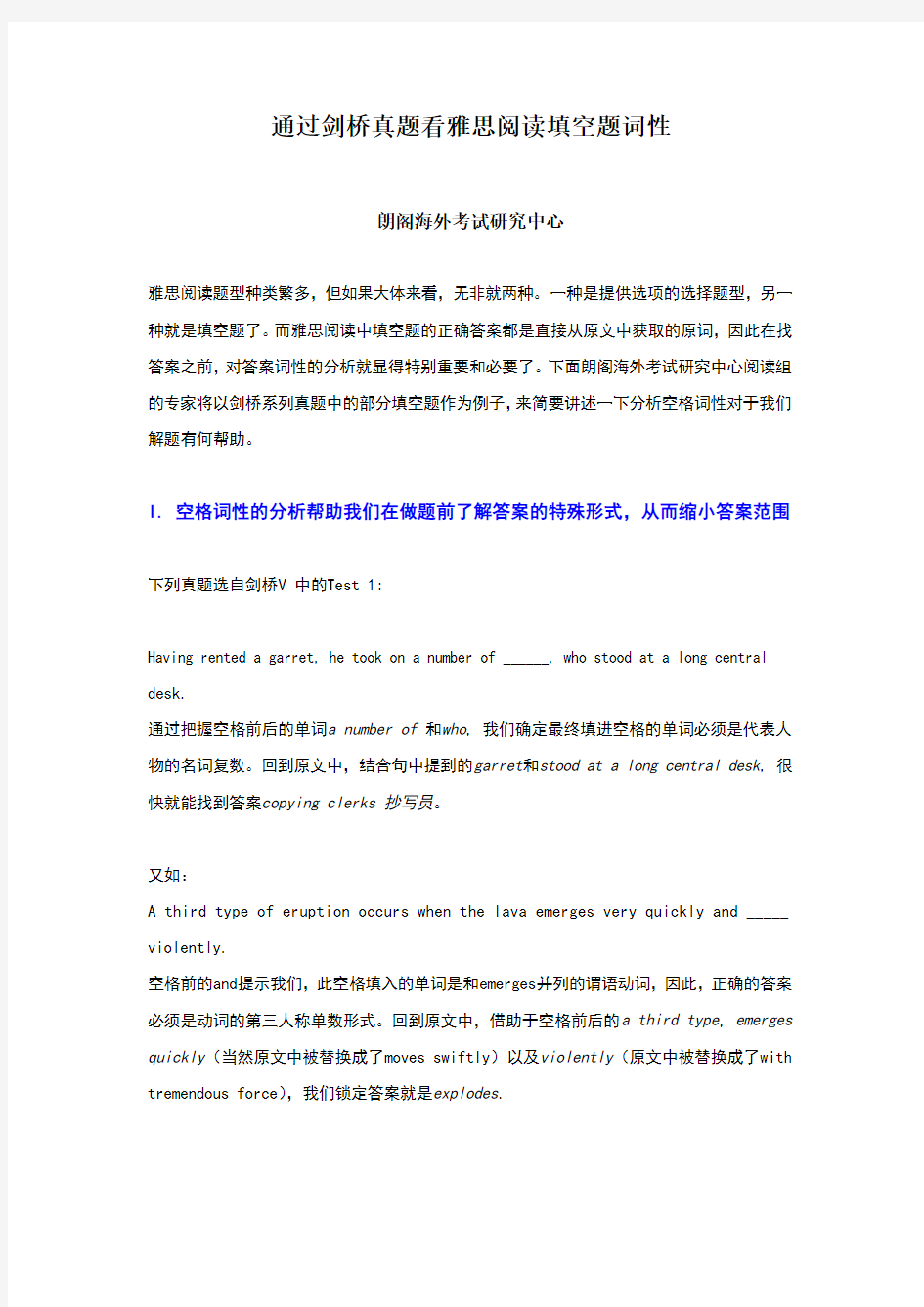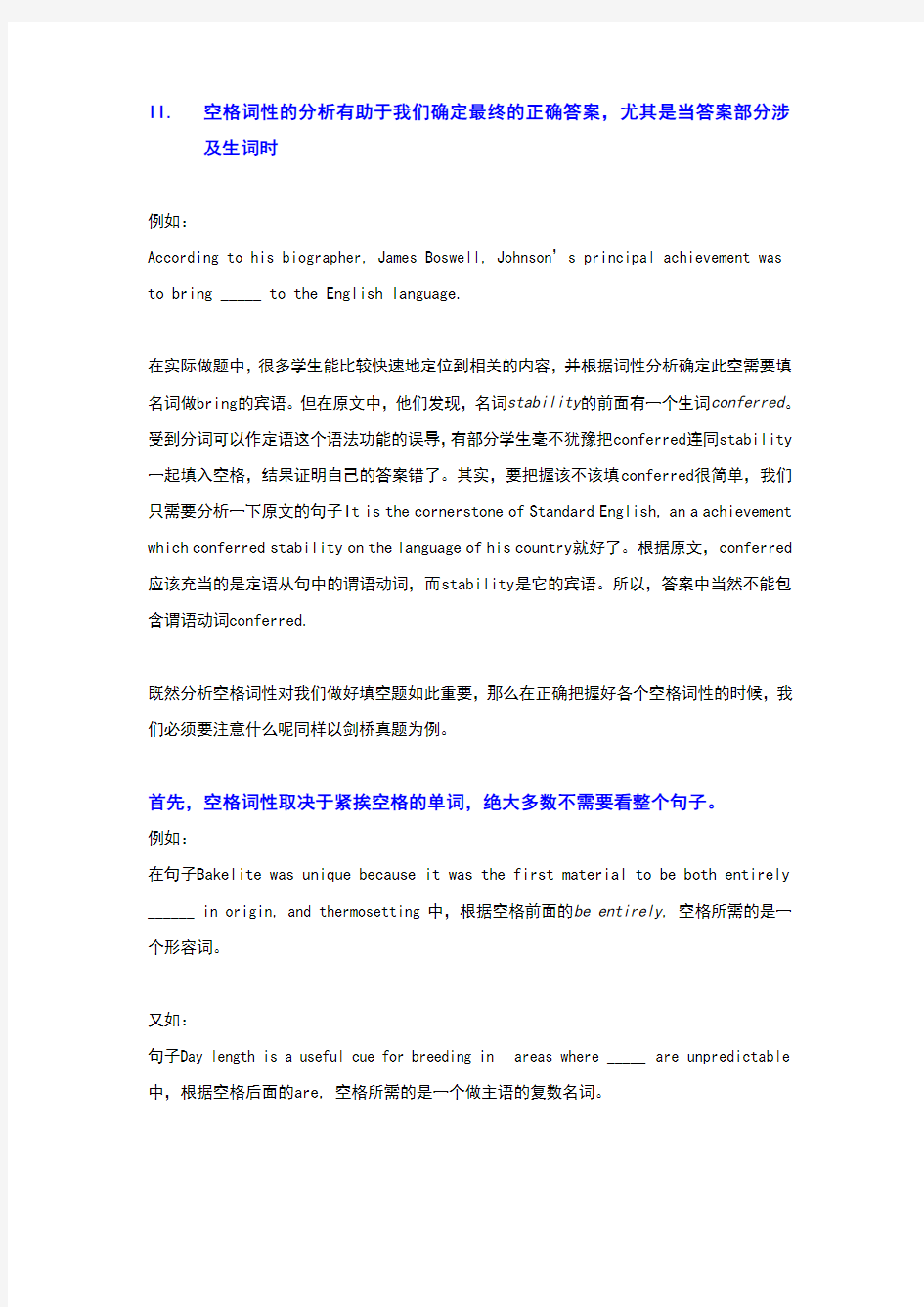通过剑桥真题看雅思阅读填空题词性


通过剑桥真题看雅思阅读填空题词性
朗阁海外考试研究中心
雅思阅读题型种类繁多,但如果大体来看,无非就两种。一种是提供选项的选择题型,另一种就是填空题了。而雅思阅读中填空题的正确答案都是直接从原文中获取的原词,因此在找答案之前,对答案词性的分析就显得特别重要和必要了。下面朗阁海外考试研究中心阅读组的专家将以剑桥系列真题中的部分填空题作为例子,来简要讲述一下分析空格词性对于我们解题有何帮助。
I.空格词性的分析帮助我们在做题前了解答案的特殊形式,从而缩小答案范围
下列真题选自剑桥V 中的Test 1:
Having rented a garret, he took on a number of ______, who stood at a long central desk.
通过把握空格前后的单词a number of 和who, 我们确定最终填进空格的单词必须是代表人物的名词复数。回到原文中,结合句中提到的garret和stood at a long central desk, 很快就能找到答案copying clerks 抄写员。
又如:
A third type of eruption occurs when the lava emerges very quickly and _____ violently.
空格前的and提示我们,此空格填入的单词是和emerges并列的谓语动词,因此,正确的答案必须是动词的第三人称单数形式。回到原文中,借助于空格前后的a third type, emerges quickly(当然原文中被替换成了moves swiftly)以及violently(原文中被替换成了with tremendous force),我们锁定答案就是explodes.
II.空格词性的分析有助于我们确定最终的正确答案,尤其是当答案部分涉及生词时
例如:
According to his biographer, James Boswell, Johnson’s principal achievement was to bring _____ to the English language.
在实际做题中,很多学生能比较快速地定位到相关的内容,并根据词性分析确定此空需要填名词做bring的宾语。但在原文中,他们发现,名词stability的前面有一个生词conferred。受到分词可以作定语这个语法功能的误导,有部分学生毫不犹豫把conferred连同stability 一起填入空格,结果证明自己的答案错了。其实,要把握该不该填conferred很简单,我们只需要分析一下原文的句子It is the cornerstone of Standard English, an a achievement which conferred stability on the language of his country就好了。根据原文,conferred 应该充当的是定语从句中的谓语动词,而stability是它的宾语。所以,答案中当然不能包含谓语动词conferred.
既然分析空格词性对我们做好填空题如此重要,那么在正确把握好各个空格词性的时候,我们必须要注意什么呢同样以剑桥真题为例。
首先,空格词性取决于紧挨空格的单词,绝大多数不需要看整个句子。
例如:
在句子Bakelite was unique because it was the first material to be both entirely ______ in origin, and thermosetting中,根据空格前面的be entirely, 空格所需的是一个形容词。
又如:
句子Day length is a useful cue for breeding in areas where _____ are unpredictable 中,根据空格后面的are, 空格所需的是一个做主语的复数名词。
其次,朗阁海外考试研究中心提醒考生,当空格前的单词为to时,注意判断to 是介词还是不定式的标志。如:
1. Right prefrontal cortex lights up- area of brain linked to _______
2. Desert annuals respond to _______ as a signal for reproduction.
3. Some plastics behave in a similar way to _________ in that they melt under heat and can be molded into new forms.
以上3个空格都不可能填动词原形,因为to都是介词,答案只有可能是名词或动名词。
剑桥雅思阅读课堂笔记
The Analysis and Solution of Cambridge IELTS (4、5、6、7) 环球雅思温亮明 IELTS Reading(剑4. 5. 6. 7) 第1章IELTS中关于阅读文章中是非判断题分析 是非题中关于“only”题的总结(共11题,8F, 2NG , 1T) 总结:剑4、5、6中共有“only”题(是非判断)7小题,5题F,2题NG,剑7中共有“only”题(是非判断)4小题3F,1T。F机率远大于NG及T 是非题中关于比较级的总结(共24题,5F, 12NG, 7T) 剑7中比较级考点(是非判断)共计4小题1F,2NG,1T 剑4.5.6比较级考点(是非判断)共计20小题,6T,10NG,4F 总结:NG>T>F 是非判断题中同级比较(the same …as…)(…as well as…)的总结 剑4.5.6共计the same …as题4道2T,1NG,1F 剑7共计2题同级比较,1T,1 F 总结: 剑4.5.6.7 阅读真题中同级比较考点无规律可循 剑桥IELTS阅读文章中是非判断题解决方法 1、是非判断题的出题顺序与其在原文中定位句(处)的顺序是一致的,所以做此类题时必须有方向感,即Q1题在文中定位要在Q2前边,Q2题在原文中定位句要在Q3原文定位处前边……例如:剑5,P23,T1P2Q26 题目中独特定位词为sociobiology,在和中都出现了,第一次出现是在Q25题原文定位处的前面,第二次出现在Q25题原文定位处的后面,因为Q25与Q26两题具有顺序性,所以Q26题的答案应在原文Q25题原文定位处的后面的中定位,而不是在Q25题原文定位处的前面的找答案。 注意:此规律内容并非绝对,但基本成立。 2、剑桥IELTS是非判断题基本上是考查原文中连续段落,即几个是非判断题在原文中的定位处是几个连续顺序的段落,或这些是非判断题集中于原文某一个或某两个段落,但无论是何情形,定位处(句)仍旧是按顺序的。注意:此规律并非绝对,定位处的连续性基本上正确。 3、据考证是非题干中划线的定位词在文中的定位基本上是首次出现时进行定位划线,个别时候,在二次出现时定位,极个别时正确答案在三次以上原文出现时定位。 4、IELTS文章的题目,除List of Headings考段落、Sections主题,或文章后边一个单个选择题考整篇文章title之外,几乎所有阅读文章题目都是针对整篇文章的不同信息点设置的,每个题目所考内容只是整个文章中的一个信息点,而整篇文章是由多个信息点构成的一个层面,考试时间有限,考生使用的答题时间有限,IELTS考官设置试题时必须给予考生一定的解题线索,没有解题线索,此考题出题失败,而每个是非题目中的定位词(关键信息词)就是考生在原文中找到出题点的钥匙,所以把题干中的定位词(题干信息点)确定之后,找其在原文的重复出现或找其在原文中的同义替换,就可以确定本题在文章中的定位处(出题句),题目中的考点词与定位词同处于一道题目中,考点词与定位词之间肯定存在某种逻辑关系,基本上在文中找到定位句后(通过题干中定位词找在文中的对应定位词),就可以在定位句找到与题目中考点词有密切关系的答案信息,这是解决是非判断题最科学有效的方法,切记雅思所有题目实质上就是找题目信息点与原文信息点的逻辑对应。
剑桥雅思口语真题解析
剑桥雅思口语真题解析 Part 1: 1.1姓名 1. What’s your full name? 2. Can I have your name, please? 3. Are there any special meanings of your name? 4. Do you like your name? Why? 5. Do Chinese people like changing their names? 6. What kind of people in China like changing their names? 7. Is there any rule for Chinese people giving names to their children? 1.2故乡 My hometown is Guangzhou. It is the capital of Guangdong province in the southwest of China. It is a large industrial city. It is close to Hong Kong so a lot of the industries involve trade and retail. It is also a finance area. The people in Guangzhou are very genial and helpful, also are very easy to get around. If you lose your way and ask someone, he will give you the direction immediately, he can also give you a hand if you are in trouble. By the year 2011, it is believed that my hometown Guangzhou has become the economic center of China. 2. Where is it located? 3. How about the climate in your hometown? Which season do you like? In my hometown Guangzhou, the four seasons are not evident, which only has spring and summer. It is too hot in the summer and it is also humid in the winter. I like summer better, for we will go swimming and start our outdoor activities in the summer, it gives us pretty environment, which full of various kinds of colors. Another reason is that it is suitable for traveling around. 4. How about the people in your hometown? The people in my hometown Guangzhou are very genial and helpful, also are very easy to get around. People will always give you a hand with things. If you lose your way and ask someone, he will give you the direction immediately, he can also give you a hand if you are in trouble. 5. What do most people do in your hometown? 6. Oh yes. Even though Guangzhou is very modern, it has some interesting temples and streets. There is one called the Temple of Six Banyan Trees and it was built about 1500 years ago. There is also a famous cultural and commercial street in Guangzhou called Beijing Road. In this street, you can not only see a historic exhibition about different years roadbed, which has more than thousand histories, but also has many business shops sale almost all kinds of things. Besides, you can taste traditional snacks and refreshments or experience temples with /unusual special architectural style nearby. Anyway, it is an interesting place so worth to visit! 7. How about the style of the building in your hometown? 8. What is one of the greatest changes having taken place over the years? 9. What problems still exist in your hometown? 10. How to improve the situation in your hometown? 11. Where is Chinese population mainly distributed? 12. What changes have occurred in people’s dwelling? 1.3学习 1. Are you an employee or a student? (Are you working or studying?) 2. What is your major?
剑桥雅思7阅读解析汇报test4
Question 1 答案:TRUE 关键词:large numbers of people, build the pyramids 定位原文: 第1段第2句: “The conventional picture is that…” 解题思路: 此题通过定位词可以迅速定位至首段第2句话,题干对文章定位句的概括性改写分析如下:generally believed — conventional picture, large numbers of people — tens of thousands of slaves. 因此答案很明显应该是TRUE。 Question 2 答案:FALSE 关键词:hieroglyph, Egyptian monument 定位原文: 首段第5句: “While perusing a book…” 解题思路: 此题定位词在文中原词出现,可以快速定位。文中定位句指出Clemmons是在一本关于埃及古迹的书中读到的象形文字信息,而题目却说她在一座埃及古迹的墙上发现了象形文字,显然题目与文章相悖,因此此题答案为FALSE。 Question 3 答案:NOT GIVEN 关键词:experiment, bird flight 定位原文: 无 解题思路: 题干的定位信息在文章中未出现,此题为最典型的“原文完全未提及型”,故答案为NOT GIVEN Question 4 答案: TRUE 关键词:theory 定位原文: 第4段首句:”Earlier this year...”今年早些时候,他们把Clemmons空头理论付诸实验 解题思路: 题目与文章完全相符,因此此题答案为TRUE Question 5
雅思阅读判断题型解题方法
雅思阅读判断题型解题方法 雅思阅读板块题型多样,其中判断题是必考题型,本文以剑桥雅思阅读真题为例,和大家解析雅思阅读中判断题型的解题方法。 剑桥雅思阅读真题解析判断题型解题方法 一、判断题题干有表示比较关系的词,考生需注意题目重点考察比较关系。 常见的比较关系词: 比较级:more/ less /adj-er than… 同级比较:as…as…/the same as…/equal/ like 试题中若出现以上比较关系词,需标记题中的比较对象(A 、B),并明确比较逻辑(如A比B更聪明),即可快速完成审题。如: 39. It is easier to find meaning in the field of science than in the field of art. – Test 2, Cambridge IELTS 11 审题步骤: 1.确定比较对象:A – field of science (科学领域)、B – field of art (艺术领域) 2.确定比较逻辑:科学的含义比艺术的含义更容易被人们理解(easier to find meaning)。 除了上述较明显的比较关系词外,出题人还会使用较隐晦的表达阐述比较关系,用以干扰考生的判断。因此,在审题时还需注意下列
具有隐含比较关系的表达: prefer to… compare to/compare with/contrast similar to…/similarly superior to/inferior to unusual 同样,考生在判定题干存在比较关系后,需标记题中的比较对象并明确比较逻辑。如: 35. Teachers say they prefer suggestopedia to traditional approaches to language teaching. – Test 1, Cambridge 7 1.确定比较对象:A –suggestopedia(暗示教学)、B –traditional approaches(传统教学方法) 2.确定比较逻辑:暗示教学比传统教学方法更受老师喜欢(teachers say they prefer)。 二、借助以下2种解题思路辅助解题: 1.题干中A、B存在比较关系但原文A、B不存在比较关系时,答案应为未提及——NOT GIVEN。 先看个简单的例子: 题干:喜茶比星爸爸贵得多。 原文:我的意中人是个盖世英雄,有一天他会踏着七彩祥云,排
剑桥雅思9阅读解析test2
剑桥雅思9阅读解析test2
Passage1 Question 1 答案: H 关键词: national policy 定位原文: H段第1句“The New Zealand Government…” 解题思路: 这一段的首句就以一种叙事口吻向考生交代了新西兰全国上下正在开展的一场为残疾人服务 的战略,该句含义为“新西兰政府已经制定出一项‘新西兰残疾人事业发展战略’,并开始进入广泛咨 询意见的阶段。”另外,在该段其它语句中也提到the strategy recognises..., Objective 3...is to provide...等信息,非常符合题干中account一词的含义。 Question 2 答案: C 关键词: global team 定位原文: C段最后一句“The International Institute of…” 解题思路:这句含义为“在世界卫生组织的建议下,国际噪声控制工程学会(I-INCE)成立了一个国际工作小组来”,这句话中international能够对应题干中的global, 而working party能够对应team。这是对应关系非常明显的一道题目。 Question 3 答案: B 关键词: hypothesis, reason, growth in classroom noise 定位原文: B段第3句“Nelson and Soil have also suggested...” 解题思路:在该段首句中就出现了classroom noise这个词,因此该段有可能就是本题的对应段落。在接下来的叙述Nelson and Soil have also suggested...中,suggest一词能够对应题干中的hypothesis 后一句中的This all amounts to heightened activity and noise levels,与题干中的one reason相对应 Question 4
剑桥雅思Test阅读Passage真题解析
剑桥雅思Test阅读Passage真题解析
————————————————————————————————作者:————————————————————————————————日期:
剑桥雅思7 Test4阅读Passage1真题解析 篇章结构 体裁说明文 主题线牵金字塔 结构引言:引出Marcus Chown的新观点。 第一段:介绍Marcus关于金字塔修建的新观点。 第二段:该观点引起另一位科学家Morteza的兴趣。 第三段:为验证该观点提出的实验假设。 第四段:实验获得成功。 第五段:对实验结果的分析。 第六段:对该观点存在不同的声音。 第七段:对于该观点的其他解释及依据。 第八段:该实验在现实中的应用。 必背词汇 引言 pyramid n. 金字塔reckon v. 料想 第一段 conventional adj. 通常的,常规的hieroglyph n. 象形文字,图画文字slave n. 奴隶odd adj. 古怪的 drag vt. 拖,拉posture n. 姿势 sledge n. 雪橇via prep. 经由 back up 支持mechanical adj. 机械的 software n. 软件giant adj. 巨大的 consultant n. 顾问wonder v. 好奇 peruse vt. 翻阅,浏览object n. 物体 monument n. 历史遗迹,遗址 第二段 intrigue v. 激起……的兴趣keen adj. 强烈的,浓厚的 contact v. 联系puzzled adj. 困惑的 aeronautics n. 航空学spark v. 激发 institute n. 学院apparently adv. 显然 fascinate v. 强烈地吸引investigate v. 调查,研究 第三段 column n. 柱,圆柱sustain v. 维持 horizontal adj. 水平的pulley n. 滑车,滑轮 vertical adj. 垂直的magnify v. 放大 source n. 来源rig v. 装配 initial adj. 最初的tent-shaped adj. 帐篷形状的 calculation n. 计算scaffold n. 支架
